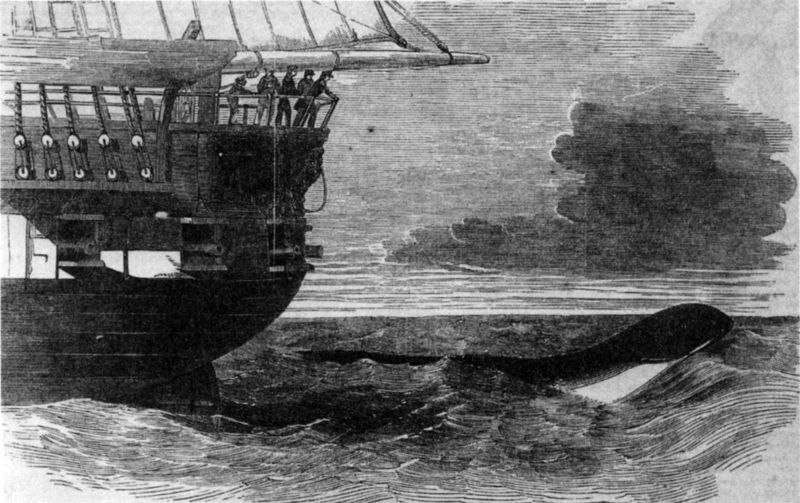Long Beach & Sea Serpents
Posted by: Loren Coleman on December 5th, 2008
I will be on the RMS Queen Mary at Long Beach, California, greeting fans and friends, signing and selling a wide variety of my books, next Monday and Tuesday.

On Monday, December 8th, at 11:30 am, on that Art Deco ship, I’ll be giving a talk on “Sea Serpents and Cryptozoology.”
Here’s an updated clarification: I am speaking at a sold-out conference on the Queen Mary, but I can be visited at my table by anyone coming into the public lobby. Also, my talk is free and open to my guests and visitors from the public, as long as you know you cannot go to other talks at this conference or the TAPS/Ghost Hunters special events and tours of the ship. (Yes, I know Jason and Grant, they will be there, and I write a regular column on cryptozoology for TAPS Paramagazine.)
Intriguingly, the 1848 sighting of the above unknown Atlantic Ocean marine cryptid, as seen from the ship HMS Daedalus, does match, in appearance, the similar kind of Sea Serpents seen off California.
About Loren Coleman
Loren Coleman is one of the world’s leading cryptozoologists, some say “the” leading living cryptozoologist. Certainly, he is acknowledged as the current living American researcher and writer who has most popularized cryptozoology in the late 20th and early 21st centuries.
Starting his fieldwork and investigations in 1960, after traveling and trekking extensively in pursuit of cryptozoological mysteries, Coleman began writing to share his experiences in 1969. An honorary member of Ivan T. Sanderson’s Society for the Investigation of the Unexplained in the 1970s, Coleman has been bestowed with similar honorary memberships of the North Idaho College Cryptozoology Club in 1983, and in subsequent years, that of the British Columbia Scientific Cryptozoology Club, CryptoSafari International, and other international organizations. He was also a Life Member and Benefactor of the International Society of Cryptozoology (now-defunct).
Loren Coleman’s daily blog, as a member of the Cryptomundo Team, served as an ongoing avenue of communication for the ever-growing body of cryptozoo news from 2005 through 2013. He returned as an infrequent contributor beginning Halloween week of 2015.
Coleman is the founder in 2003, and current director of the International Cryptozoology Museum in Portland, Maine.











That’s great; the Queen Mary is down the street from me. I have been looking to pick up your Cryptozoology A to Z or Mysterious America.
I really like the story behind the Daedalus. Something about how the amount of witnesses involved and the remarkable consistency of their story.
It would be nice to go and get to buy one of your books ( i dont have one, but im interested ) but waayyyy too far away from me. I live all though way down in Indiana, so it would take me about A week to drive there.
Interesting, though. Similar species living on complete opposite sides of a continent. But the enviornments would be fairly similar, so i can see similar creatures developing. Convergent evolution.
and some ignorant people actually believe that there are no sea serpants and that these things don’t doesn’t exist! >=(
Figures, I just get back from Cali and then Loren heads out there.
Very interesting story behind the Daedalus.
I live in So Cal and would be interesting in attending (hour drive).
What are the times you will be there Loren (on the 8th and 9th correct?)?
What are the California sightings you allude to?
I have been here 45 years and never heard anything
It sounds like fun, unfortunately a bit out of the way for me 🙁
do you happen to know those two jokers Steve & Tango?
Do I know “Steve & Tango”?
Nope.
Amy? Chris? Amber? Kris? Jeff? Tim?
Yes, and many others but not “Steve and Tango.”
Great thread and news, Loren.
I’ve always loved the “Daedalus” flap, both because of the “sighting” itself and the “seeming” reliability of the ship’s captain, M’Quahe. Experienced sea dogs like him were more than qualified to verify what was or was not an “ordinary sea creature.”
I wonder what Loren thinks of the theory put forth by Oberon Zell-Ravenheart (he who was able to “create” an unicorn) in his A Wizard’s Bestiary, that the beasts seen in 1848 and other occasions down throughout the years were “Giant Sea Slugs.” I’m open to a lot of theories but that doesn’t sound right to me. 🙂
A majority of 19th century “reports” of sea serpents and lake monsters are obviously overly sensationalist hoaxes or satirical material whipped up by newspaper editors to fill space.
But the HMS Daedelus account does not conform to those patterns. The manner in which the crew reports the creature is more one of curiosity and puzzlement…not what hoaxers typically strive for in a prank. I think they saw something they couldn’t explain. Exactly what it was, we will never know unless deep sea research oceanography reveals some new and rather gigantic species in the dark zones.
Cryptidsrus- Yes, the Deadalus is definitely one of the more intriguing historical sightings. Everything just falls right into place to make it one that cannot really be brushed off lightly.
I’m agree, I’m not so sure of the sea slug theory either. I find it highly unlikely that a sea slug would be up at the surface cavorting about and creating a sighting like this. They just simply aren’t surface dwelling, pelagic, open water swimming animals. There’s not a whole lot of biological facts I can think of that would support that hypothesis.
I have no idea what the creature described was, but I highly doubt it was a giant sea slug.
Keep in mind that the Daedalus story, as interesting as it is, might not represent an unknown species. While the drawing done for a newspaper under Captain McQuahe’s supervision can’t be matched to any animal known to be living today, vertebrate or invertebrate, a firsthand drawing by a watch officer named Drummond showed much less detail on an animal much further away from the ship. If Drummond was correct, Richard Ellis’ explanation of a giant squid at the surface becomes a possibility. I think Ellis has relied too much on this explanation, especially when he tried to apply it to the Valhalla case, but we should recognize that the most famous drawing of the Daedalus creature may not be the definitive one.
The biological origin “bloop” indicates that there’s still some unknown animals in the deeps. Big ones.